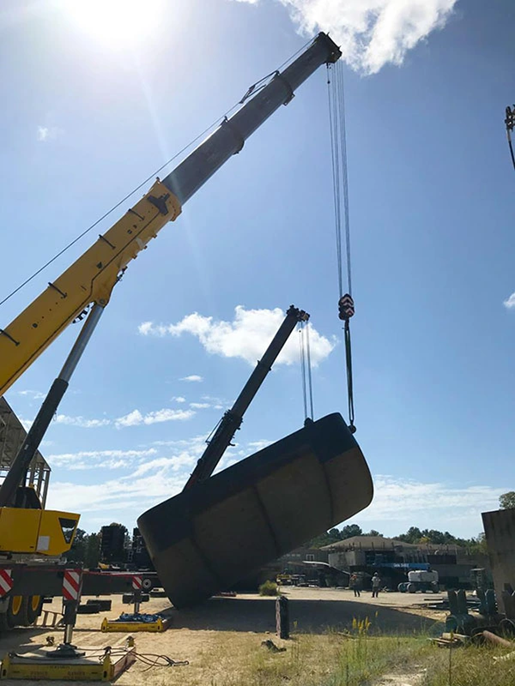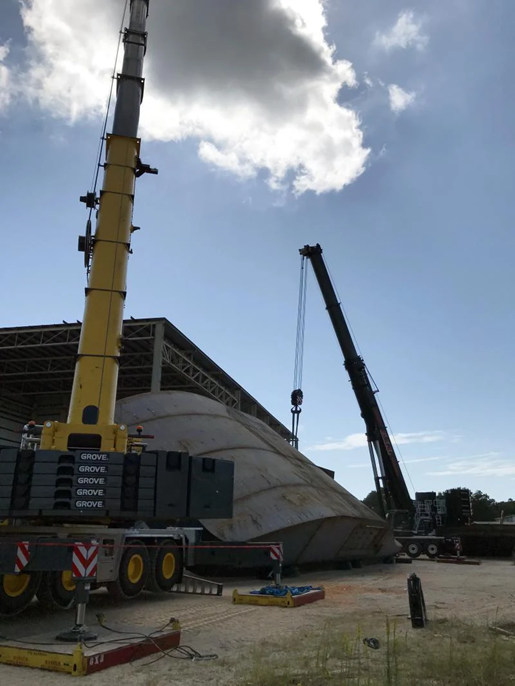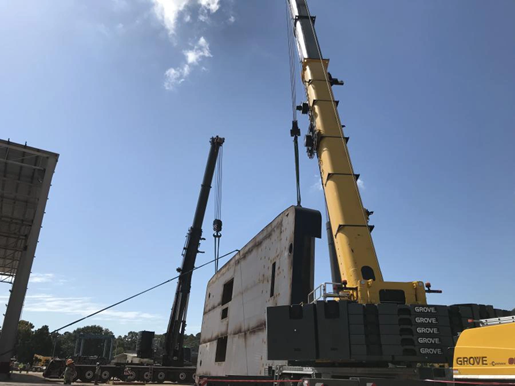
Bayou La Batre, Alabama, sits right on the Gulf of Mexico, a fishing village so well-known that its four seasons are said to be shrimp, crab, oyster and fish. With an economy initially dependent on the bounty of the local waters, the town has also emerged as one of the world’s leading locations for shipbuilding (at one point, it was even known as “the Detroit of shrimp trawlers”).
Trawlers are still a mainstay, although these days, the shipbuilding happening in Bayou La Batre has evolved to encompass everything from tugs, barges, and oil supply vessels to cruise boats, yachts, and ferries. Finished vessels are exported all over the world.
Finishing construction of some of these ships requires cranes supplied by ALL Crane Rental of Alabama, a member of the ALL Family of Companies. Particularly when it’s time to “turn” a hull – flipping it from upside down to right side up – that weighs hundreds of thousands of pounds.
A boat’s hull is a curved structure that sits mostly below the waterline. Many hulls are first built upside down then turned over before construction is completed on the full vessel. Although shipbuilders often own their own cranes for this crucial step, some hulls are simply too heavy and large, and require the specialty cranes ALL is able to provide.
Why build a hull upside down? It’s easier to make sure the top part (the “bottom” when it’s under construction) remains flat for joining to the rest of the boat. It’s also easier for welders to work in a down and across direction rather than over their heads. It’s actually faster and more efficient to build the hull upside then bring in cranes to turn it at the appropriate juncture.
Scott Swearengin, sales representative from ALL Crane Rental of Alabama, says hull turns, also called boat rolls, have been a regular part of the annual workload at the branch for his entire 17-year tenure. “I’ve helped with turns in which a 200,000 pound hull is flipped in the air,” said Swearengin. “On the opposite end of the spectrum, I’ve seen jobs involving hulls that weigh 900,000 pounds. When they’re that heavy, they literally are ‘rolled’ – using the earth to handle 50% of the load as the cranes guide it over.”
For one recent hull turning, Swearengin specified two 550-ton all terrain cranes, a Grove GMK7550 and Liebherr LTM 1450-8.1. The hull weighed 520,000 pounds and measured 76 feet long, 35 feet wide, and 10 feet deep. The Grove was configured with 84 feet of main boom, 100% outriggers and 264,500 pounds of counterweight at a 35-foot lift radius. The Liebherr had 87 feet of boom and 295,400 pounds of counterweight, also with 100% outriggers and a 35-foot radius.
Maintaining an equal radius is critical to a successful outcome. “During the initial setup of these jobs, it’s important that the hull is positioned exactly between the cranes,” said Swearengin. “We have to make sure that, as each crane is reaching to grab its lifting eye and maneuvering through the turnover, the hull remains dead center. It has to be a mirror image.” Positioning of the lifting eyes, which are temporary welds applied to give the cranes something to rig to, are also dictated by the radius to help ensure equal load between the two cranes.
This type of roll, in which the hull never completely leaves the ground, can take approximately 45 minutes to execute. Turns that happen in the air can take significantly longer, usually around two hours.
Once the hulls are right side up, the shipyard completes construction and ALL returns at a later date with more cranes to assist with placing the wheel houses on the hulls.
Given the location on the Gulf, storms happen frequently and can scuttle scheduled rolls. Ground conditions can also change rapidly based on recent rainfall. Swearengin and the ALL team in Alabama remain at the ready to accommodate their valued shipbuilding customers.
“We’ve worked on dozens upon dozens of boat rolls over the years,” said Swearengin. “The shipyards are vital to the local economy and we’re happy to help.”

